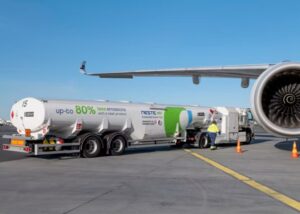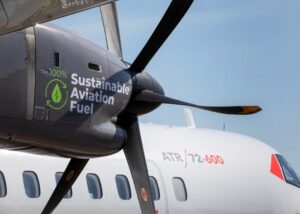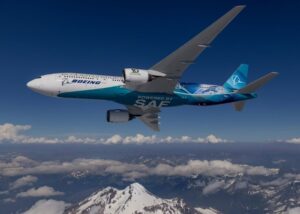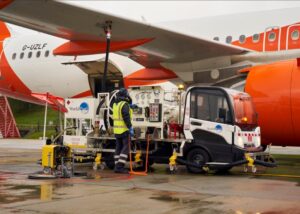Omar Memon from Simple Flying – Reports
SUMMARY
- Sustainable Aviation Fuels (SAF) are made from renewable waste materials and can reduce emissions by up to 80% compared to conventional jet fuel.
- SAF production involves collecting feedstock from various sources and converting it through processes like Fischer-Tropsch and Hydrotreated Esters and Fatty Acids.
- The maximum allowable blend of SAF with conventional jet fuel is currently 50% for commercial flights, but up to 100% can be used on modern airliners. SAF transportation methods include pipelines, barges, and trucks.

Sustainable Aviation Fuels (SAF) have been in the news as the future combat against aviation-related global warming. Airlines are gradually increasing the use of SAF as part of their initiatives towards net-zero emissions.
According to Neste, the world’s leading producer of sustainable aviation fuels:“Aviation currently accounts for approximately 2 to 3% of global carbon emissions. Counting non-CO2 emissions, its overall contribution to climate change is significantly higher — and likely to rise as demand for air travel keeps increasing. The world needs a solution to decarbonize the aviation industry today.”
Waste Recovery
Step 1: Feedstock is collected
- Biomass
- Fats, oils, and greases
- CO2 from Direct Air Capture (DAC)
The first step in the process is the recovery of feedstock from multiple sources. Feedstock is generally collected from both renewable and nonrenewable sources, including biomass, fats and oils, grease, and CO2 from Direct Air Capture (DAC).

According to Neste: “SAF is made from 100% renewable and sustainably sourced waste and residue raw materials, such as cooking oil and animal waste fat, and it could reduce GHG emissions by up to 80% over the fuel’s lifecycle compared with using conventional jet fuel.”
SAF Production
Step 2: Feedstock conversion to SAF
- Major technologies
- Fischer-Tropsch (FT)
- Hydrotreated Esters and Fatty Acids (HEFA)
- Synthesized Iso-Paraffins (SIP)
- Alcohol to Jet (AtJ)
- Catalytic Hydrothermolysis (CHJ)
The next step in the process is to convert recovered feedstock into SAF. This is done through a variety of methods and technologies. The Fischer-Tropsch (FT) method breaks carbon materials into building blocks of a synthesis gas form. The FT synthesis combines the blocks into varying sustainable fuels. The maximum blend ratio is 50%.

The HEFA process refines waste oils and fats into SAF through hydrogenation. The oxygen is removed from the residual through hydrodeoxygenation and the molecules are isomerized to jet fuel chains. The maximum blend ratio is 50%.
The SIP is a biological method containing microbes that convert C6 sugars into farnesene. The resultant farnesene is treated with hydrogen to be used as SAF. The maximum blend ratio is 10%.
Creating the blend
Step 3: SAF is blended with conventional jet fuel
- Maximum allowable blend for commercial flights 50%
- Maximum allowable blend for test flights 100%
The next step in the process is mixing the produced SAF with the conventional jet fuel. Currently, the use of SAF is limited to a 50% blend for commercial aircraft, including fighter jets and helicopters. The limitations are due to the passive use of conventional jet fuel for engine systems. For example, the sulphur content in jet fuel allows fuel seals to swell in engines, preventing fuel leaks.

Moreover, SAF is anywhere between two times to ten times more expensive than conventional jet fuel. For some waste-based sources it may be 2-3x whereas SAF produced through some synthetic carbon-capture technologies can cost as high as 10x. The two types of fuels’ specific chemical and physical properties are carefully monitored when creating the blend.
Transportation of SAF
The transportation method depends on the existing infrastructure
- Through existing pipelines to airports
- Through barges
- Through trucks
The blended SAF is transported to airports to be used in aircraft. With the current global production of SAF less than 1% of global consumption, the supply chain and transportation infrastructure are marginal. If the SAF is blended with jet fuel at an existing petroleum refinery, it can be transferred to airports and terminals through pipeline
In many cases, though, SAF is transported on barges and trucks to airport terminals. While barge and truck transportation methods are not as safe as pipelines, these must be used in areas where pipelines are not available. In such cases, the blend is distributed from a central storage facility to airports for use. At the airports, the fuel can be stored at in-airport storage wells before being transferred to the aircraft via fuel trucks.
A sustainable flight
- Up to 100% SAF can be used on modern airliners
- Sustainable Aviation Fuel can reduce emissions By up to 80% throughout the fuel lifecycle
The blended SAF is filled on the aircraft minutes before its scheduled flight. In most cases, the existing airport infrastructure is sufficient for delivering SAF to the airport. While most modern engines are capable of using SAF (up to a 100% blend), specific measures must be taken to ensure safe operation.
According to Neste: “A direct replacement for fossil jet fuel reducing both carbon dioxide (CO2) and non-CO2 emissions, Neste MY SAF is available and in commercial use today by many airlines and at airports around the globe.”